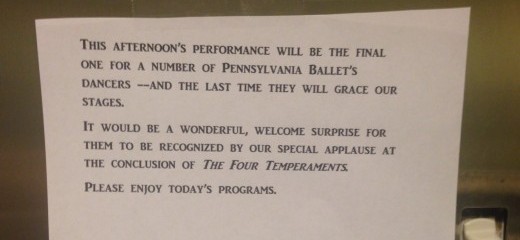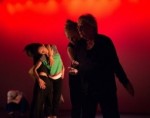
Slain by Beauty
by Megan Bridge
It’s Sunday June 12th. Fifty were killed in Orlando this morning at a gay nightclub. Obama says it’s “an attack on all of us.” Is it though? To me it seems like a targeted act of violence against gay people. I understand his point. We stand together. The nation exhales a collective sigh of sadness, of frustration, of not again.
Surely the attack affects us all. We have anger that we don’t know where to place. We snap at our children, then pull them close, thinking, what if? We wring our hands at the lack of action our lawmakers take. But at the end of the day, we are alive. I had the privilege of sitting in a lush theater this afternoon, watching the Pennsylvania Ballet’s Balanchine and Beyond. I wanted to focus my review just on one work in the program: Trisha Brown’s achingly beautiful meditation on the brilliance of the human body, O zlozony/O composite.*
And I still want to focus on that work, because of its historical significance (O z/O c is the only true ballet that Brown ever created), because of the rarity of seeing Brown’s work in this context (this is the first time a major work of hers has been performed by an American ballet company), because of the work’s delicately delicious power. While watching this piece I feel like the inside of my brain is being licked by a soft tongue. The most complicated lift launches like Da Vinci’s imagined aerial screw: Lillian DiPiazza as the floating, spinning axis around which Ian Hussey and Aaron Anker turn, passing her back and forth in a lazy cyclone of limbs that fold and spoke with simultaneous precision and effortlessness. When the three dancers drop into plié, each in a slightly different position (and nary an upright spine) time melts slowly away.
But death is on my mind.
Did you know that more than 40% of PAB’s dancers will not be returning next season? New leadership brings a new vision, and of the company’s forty-three dancers, twelve were recently let go and more have chosen to follow them. So today’s performance, the last show in the company’s season, was the final curtain for many. Most of the audience was probably unaware of this. Maybe they wondered why claques of young dancers gathered at the perimeter of the orchestra pit to throw flowers and stuffed toys at their colleagues during the final bow. Or maybe they saw the sign, sadly taped to the paper towel dispenser in the ladies’ bathroom, announcing that this would be the last PAB performance for many on stage, and that extra friendly applause would be appreciated by those moving on.
Losing a job, especially in circumstances that unfold in small affronts over the course of many months, is a deeply painful experience. Being cast out of a company that has become your extended family over many years is to be bereft. Why weren’t these dancers acknowledged at their final performance? A simple curtain announcement could have made this a joyous celebration of the years that many of them have put into this company.
And why wasn’t any mention made of the Orlando shootings? A moment of silence, or better, dedicating the program’s meditative, even somber opening work, Adagio Hammerklavier, to the victims, would have cost nothing, and would have allowed us to sit in a space of shared humanity.
At one of the intermissions, I had the fortune to bump into Lisa Kraus. Lisa danced in Trisha Brown’s company. She is the founder, and was editor-in-chief for almost four years, of thINKingDANCE. She is the force of nature behind Trisha Brown: In the New Body, a yearlong festival of the innovative choreographer’s artistry, which culminated this weekend with these performances of O zlozony/O composite. I talked to Lisa as she smiled through tears, explaining how for her, the end of this project is another small death. I get this. She conceived the project from start to finish, spending hundreds of hours fundraising, planning, and producing the multiple events that were part of it. It’s hard to pour life into something for so long and then to watch as it floats away like so much smoke.
Watching O z/O c, I savor the smoke as it dissipates, like a French inhale, and I carry it with me when I leave the theater. It’s not stale, second-hand, but more like the tang that stays in your clothes for days after a campfire. At home, I sift through some of the abundant writing about Brown’s work on the project’s website. One of O z/O c’s restagers, Neal Beasley, writes about how Brown’s work “never panders to context,” and I think about what that means in this instance. DiPiazza (who will be promoted to principal next season), Anker (who moves up from being an apprentice to a full company member), and Hussey (who continues on as principal) are clearly at home in this work. Brown’s sinuous movement vocabulary pushes at the edges of the balletic idiom in a way that enhances my understanding of how symmetry functions, especially set against the very different formalism within the other works on the program. The immediate context of Balanchine and Beyond makes O z/O c gleam.
But a nod to the larger context, the events of the day, the life of the company, would have made the whole program, and the ballet as an institution, gleam as well.
Later someone asked Lisa how she felt about the performances. She said the phrase that kept coming to her was that she was slain by beauty.
And I think… what a fortunate way to be slain.
*Also on the program was Hans van Manen’s Adagio Hammerklavier, Jean-Pierre Frohlich’s Varied Trio (in four), and George Balanchine’s The Four Temperaments.
Special thanks to Ellen Chenoweth for catalyzing many of the thoughts that came up for me in writing this article.
Balanchine and Beyond, Pennsylvania Ballet, June 9-12, Merriam Theater
By Megan Bridge
June 19, 2016










